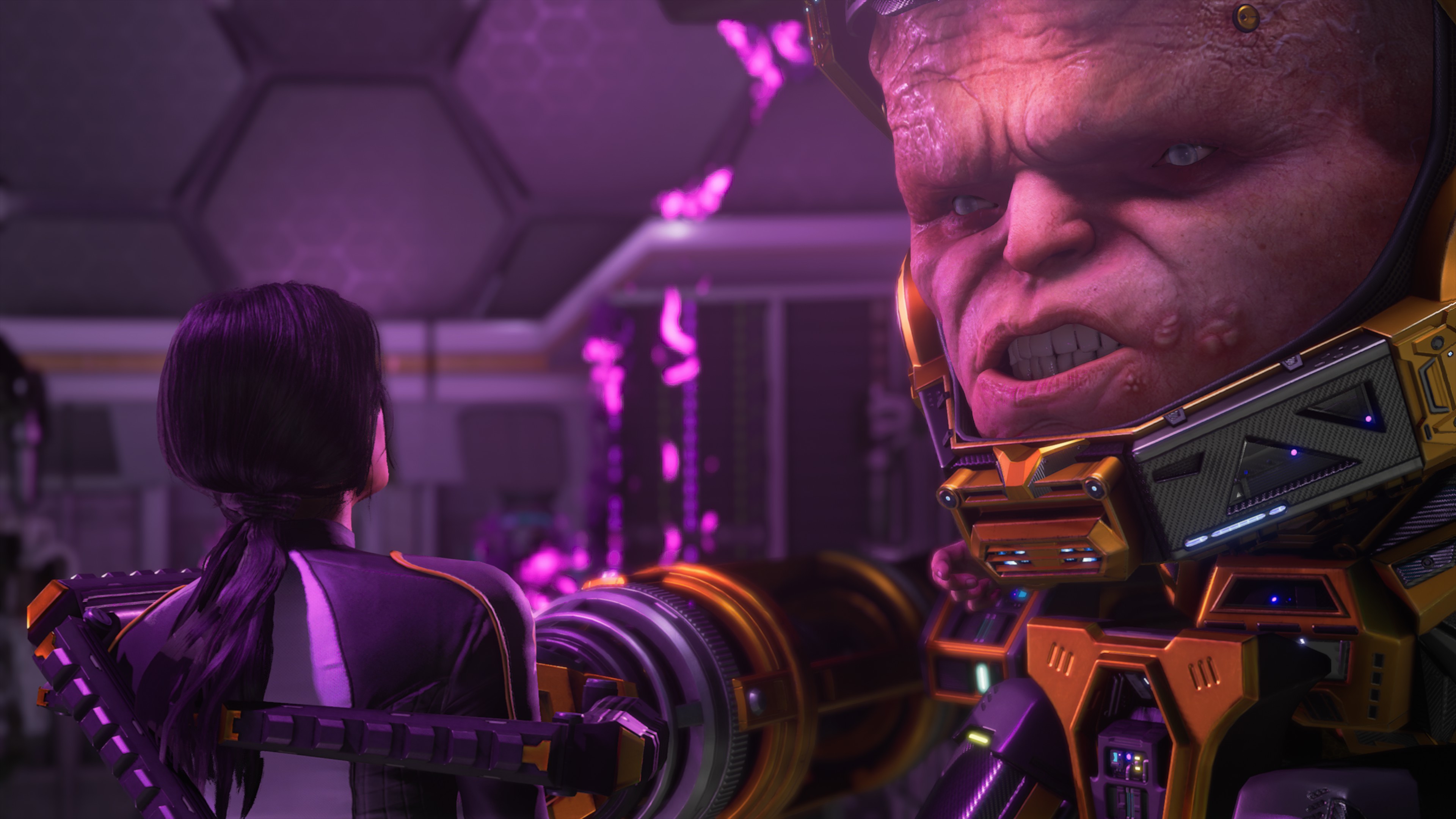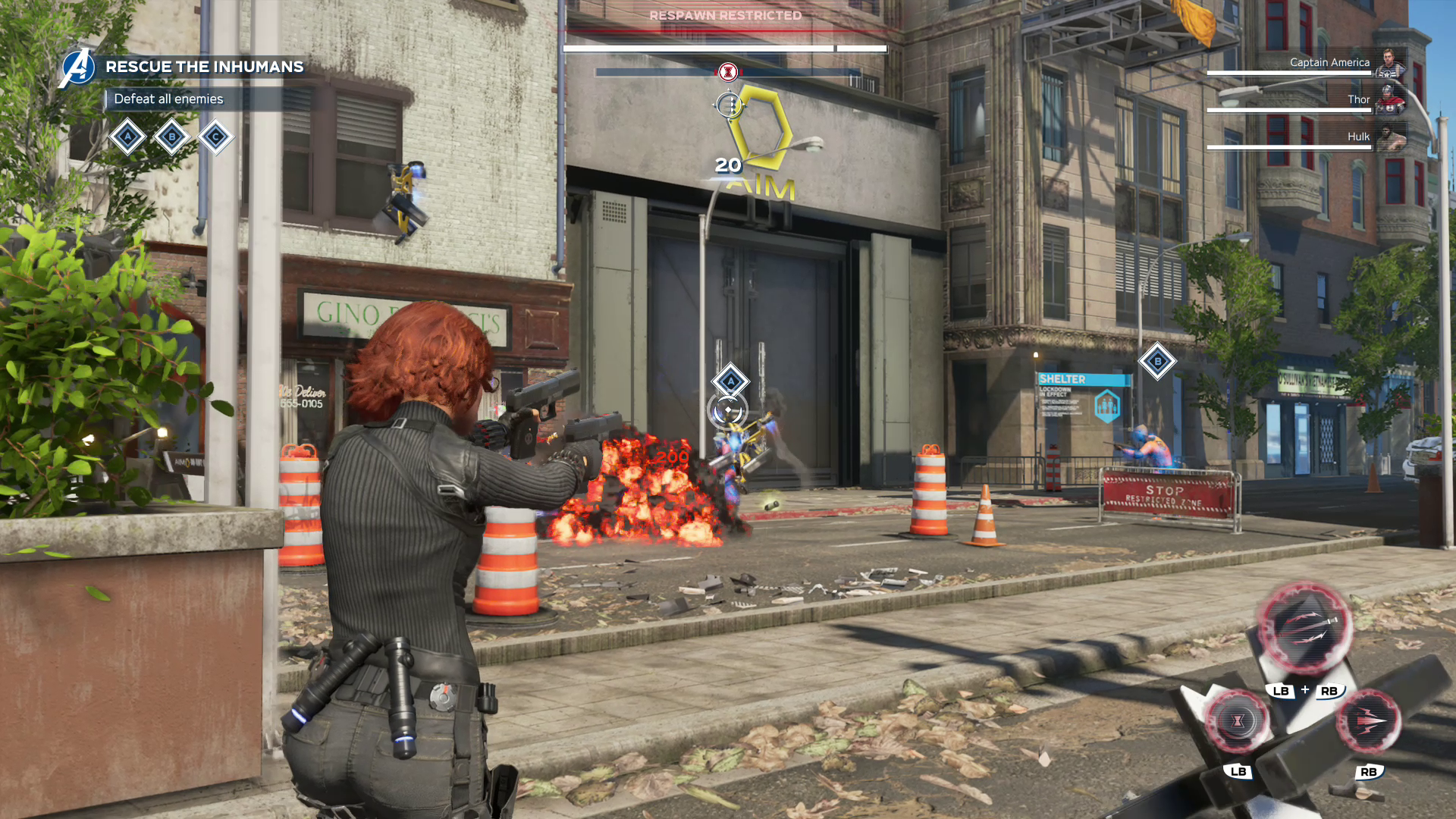So far Marvel's Avengers has a fun campaign and a tedious endgame
Our full review is coming soon.

The first few hours of Marvel’s Avengers are like a theme park ride; a freshly painted rollercoaster that safely pushes you with pneumatic smoothness through a series of vignettes where you goof around as each superhero. This is neatly encapsulated in the very first playable sequence, where you explore an Avengers fair as future Ms. Marvel Kamala Khan, meeting the whole team and generally having a good time.
It looks great—beautiful, even—as you hold the ‘W’ key to glide through linear running sequences and the occasional button-mashy scuffle. There are some QTE events, and even the lightest of stealth sequences, where the game is so kind as to automatically crouch you when you’re meant to crouch, and pull you back up when you’re meant to stand.
It feels very polished but also very safe, leaning on some excellent facial animation and voice acting to pull me into its world. It keeps me swinging those super-stretchy limbs of Ms. Marvel. In other words, it comes across as a perfectly solid movie tie-in.
But a good four hours in, there’s a shift. It turns out that Marvel’s Avengers isn’t an on-rails adventure in the style of Uncharted or Crystal Dynamics’ own Tomb Raider series, but a non-linear looter-brawler—a lightweight Destiny in spandex.
A non-linear looter-brawler—a lightweight Destiny in spandex.
After you reach the Avengers’ floating command center a few hours into the campaign, you use a map to freely drop into dozens of missions set across several distinct biomes across the world. Some you do solo, others you do alongside up to three other Avengers, who can be controlled by friends or random online players. As the campaign progresses, you steadily unlock each Avenger to play as until you have the whole crew.
Whether you’re playing a side-mission or campaign mission, the setup is largely the same. You explore a large level, look for hidden loot while pursuing the main objective, and take on waves of robotic enemies. Sometimes these melees are spiced up by you having to stay in a small blue circle longer than enemies, other times you tussle over three checkpoints Battlefield-style. There are also ‘Iconic Missions’, each of which focuses on a specific Avenger. While these tease some extra story to get sucked into, they’re actually much the same as other mission types, albeit with the potential to unlock rare or ‘Epic’ gear for that character.
The campaign’s storytelling and writing are excellent in that wholesome, distinctly Marvel way where even Iron Man uttering the word ‘Shit’ feels gleefully risqué. The game thrives during quieter, more bespoke campaign missions and the cutscenes that bind them. The relationship between Bruce Banner and Kamala Khan, for instance, unfolds beautifully. Banner’s unsure body language and mix of irritation and care he shows towards Khan—whose chirpy teenage optimism is just what 2020 needs—is outright some of the best voicework and mocap I’ve ever seen in a game.
Keep up to date with the most important stories and the best deals, as picked by the PC Gamer team.

The combat is spectacular, and it's not superficial either. You combine classic brawler moves like juggling, suspended aerial attacks and light-heavy combos with the counter-and-dodge-based style of the Arkham games (there’s even a move where you jump over a shielded enemy’s head to break their shield). Little icons on the edges of the screen let you know how close a missile or laser is to blasting you, while enemy melee attacks are telegraphed by coloured circles, which let you know whether you can dodge or parry an attack.
It gives you a lot to think about while filling your screen with a confetti of mechanised enemies and special moves executed by your fellow Avengers, and it doesn’t always feel like you—or even the game itself—can keep up. 17 hours in, I’ll still often dodge instead of parrying when the enemy attack circle is white (dodge for red, dammit!), and that all-important telegraphing of enemy moves isn’t entirely consistent, meaning that my heroic combo flow often gets broken up by attacks I had no chance to anticipate.
That flow really depends on who you play as too. Attack animations aren’t super-responsive, and jumping out of harm’s way feels floaty. Playing as the speedsters of the group, Ms. Marvel and Black Widow, feels much better than Hulk, whose lumbering style inhibits your ability to make split-second decisions.
As high-flyers Iron Man and Thor, meanwhile, you get that initial buzz from swooping into battle from way overhead of your buddies, but finer aerial maneuvering and attacks are fiddly and much weaker than melee. It’s a shame that there doesn’t seem to be any tactical benefit to having a squad combining ground-based and aerial heroes.

There’s been a lot of speculation around grind, but I can happily say that it doesn’t affect the campaign. You raise your stats through levelling up and improving gear colour-coded by its rarity. In reality, the various stats this gear effects—from critical hit chances to elements resistances—weren’t impactful enough for me to pay much attention to the numbers. In the campaign at least, I just whacked on the highest-power gear, stockpiled resources, then upgraded heavily once I got to the final mission.
I’ve now completed the main campaign, which was around 15 hours long. While normally that would be enough to warrant a full review, it’s so clearly just a glamorous red carpet into the game-as-service that the devs (and publisher) are trying to build that I need to spend some time with that too—amidst the virtual currencies, daily challenges, and endless levelling with other players.
Given that the story was such a highlight for me, I’m sceptical that pounding through these largely homogeneous missions over and over again just to get different costumes or invisible gear upgrades is going to keep my attention.

At a glance, there doesn’t seem to be anything cynical or money-grabbing about the grind this game is designed for post-campaign, but there’s nothing hugely compelling in its sparse levels or thumb-cramping mechanics at this point either. The campaign was simple but hearty, and I wonder whether any of that will carry over into the service aspect of the game that, so far, feels rather soulless.
- Marvel Avengers characters: Meet the heroes and villains
Robert is a freelance writer and chronic game tinkerer who spends many hours modding games then not playing them, and hiding behind doors with a shotgun in Hunt: Showdown. Wishes to spend his dying moments on Earth scrolling through his games library on a TV-friendly frontend that unifies all PC game launchers.

